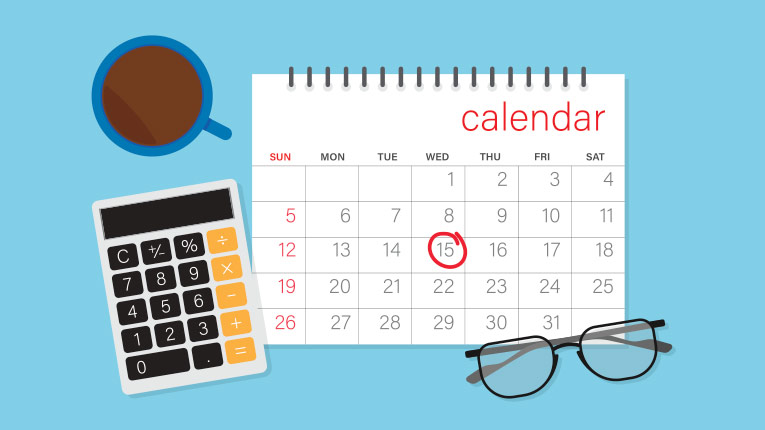6 Steps to Paying Bills On Time

Understanding how to pay your bills on time is an important part of effective money management. Not only does timely bill payment impact your credit score, late and missed payments could cause penalty interest rate increases, late fees, or your account to be sent to collections. Having a pattern of not paying bills on time could also result in credit denials, or higher interest rates when applying for loans or credit cards.
How to Pay Your Bills on Time, Every Time
If you have many types of bills, irregular income, or are living paycheck-to-paycheck, keeping your bills organized and paying them on time can be especially challenging. Here are six simple steps to help you understand how to pay bills on time and make bill paying easier.
1. Compile a list of your monthly bills.
Getting a handle on how to pay your bills on time starts with knowing what bills you have.
Using a spreadsheet or pencil and paper, make a list of your bills. Start with your largest bills first, such as your rent, mortgage, and credit cards, followed by auto loans, personal loans, or any student loan payments. Add recurring bills and expenses such as auto insurance, utilities, phone, internet, streaming services, gym memberships, childcare, etc. Include the following information for each item on your list:
Name of account/provider
Monthly payment amount
Payment due date
Payment method
Be sure to include any buy now/pay later bill payments and capture any other recurring payments. It can help to look at your bank and credit card statements to be reminded of all your creditors and the bills you pay on a regular basis.
2. Create a bill calendar.
Now that you’ve compiled a list of all your bills, it’s time to create a monthly bill calendar to help you track when each bill is due. Probably the easiest way to set this up is to use a digital calendar (such as on your phone or laptop) and color code your bill calendar entries so they stand out from your other calendared events. Or you can create a bill calendar using paper and pencil instead.To create your bill calendar, look at your current bill list and start calendaring your bills by their current due date. Include key information from your bill list, such as the creditor’s name and amount due. Next, calendar the dates you expect to receive money and how much, such as your monthly or bi-weekly paychecks. If you’re on a regular payroll schedule, note your payday schedule and the amount you normally receive. You can also include other regular anticipated income, such as a work bonus, child or spousal support, etc.
3. Review your bill due dates.
Now that you’ve created your monthly bill calendar, understanding how to pay your bills on time becomes a lot easier. Use the calendar to get a birds-eye-view of how your income fluctuates throughout the month, where your bill due dates land, and what amounts are due when. Being able to see when money is flowing in and out helps you know if you’ll have enough money in your bank account to cover those payments (and avoid overdraft and late fees). A bill calendar also makes it easier to see where you may need to adjust certain payment due dates.If a bill’s due date doesn’t align with your pay schedule, or you see that there are too many bills stacked up in one week, consider contacting your bill provider to request a change of your payment due date. Most bill payment due dates default to the beginning or the middle of the month, e.g., the first/last day or around the 15th of each month. So, if you’re paid once at the end of each month, you may want to explore whether you’re able to schedule your due dates in the beginning of the month. If you’re paid weekly, it may make more sense to spread your due dates out more evenly over the course of the month.You may be able to go into your online account to see if you can change your bill due date there. If not, contact your creditor by phone. If it makes it easier for you to pay on time, ask about splitting up larger bills so you’re making two or three payments over the course of the month, or if you can pay a bill quarterly, annually, or some other option—whatever works for you. Know your grace periods—the window of time between the date your bill is due and when you’re charged a late fee. Grace periods are usually about 15 days and can give you some flexibility in timing your bills.
4. Automate your bill paying.
One of the easiest ways to make sure you never miss a bill payment is to schedule your payments in advance. Most creditors offer some form of automated bill payment now, or you can set it up through your online bank account.If you pay directly to your creditor, you’ll need to provide a payment source to keep on file, such as a debit card or bank account information. And you’ll usually be able to select the date of your recurring payment and how much you want to pay, such as the minimum amount due or a custom amount. If you set up payments through your bank, you can also choose how much you want to pay and when.Continue to use your bill calendar to track your due dates and income. And, especially in the beginning, keep an eye on your bank balance to ensure you’ve got the funds in your bank account to cover any upcoming payments.
5. Receive alerts and reminders.
Not all bills can be automated, so if you’re having trouble remembering when a bill is due—even with a bill calendar—set up automatic reminders to help you remember. Most creditors offer a bill reminder feature built into their platform and provide options to be alerted by text or email. You could also set up reminders manually on the calendar in your phone, laptop, or daily journal (5 days before the payment due date is a good rule of thumb). Whatever you choose, bill reminders are there to alert you about upcoming payments a few days before they’re due.You may also be able to opt-in to receiving notifications about payments made, received, and any missed payments. You can also add daily, weekly, or monthly reminders to check your account balances.
6. Dedicate organized space.
How you pay your bills is just as important paying your bills on time, and that starts with keeping your bills organized. Dedicate an area in your home where you pay bills and manage financial paperwork. Whether it’s a designated folder on your laptop or a kitchen drawer, keeping everything organized and in one place is key to knowing how to pay your bills on time. Figure out what works best given your living space and organizational habits—and don’t be afraid to adjust as you go along.
The Bottom Line
Knowing how to pay your bills on time in an organized and efficient manner can help you establish a track record of on-time payments, which could have an impact on your credit score. If you’re struggling to pay your bills, check in with your creditor or lender as soon as possible. They may be able to work with you to provide solutions such as forbearance, temporarily reduced interest rate, loan extensions, or other payment options.Or you may want to consider consolidating some of your variable high-interest credit card balances, medical bills, and other outstanding debt into a fixed, lower rate personal loan. You could save money over time, lower your combined monthly payments, or both.




